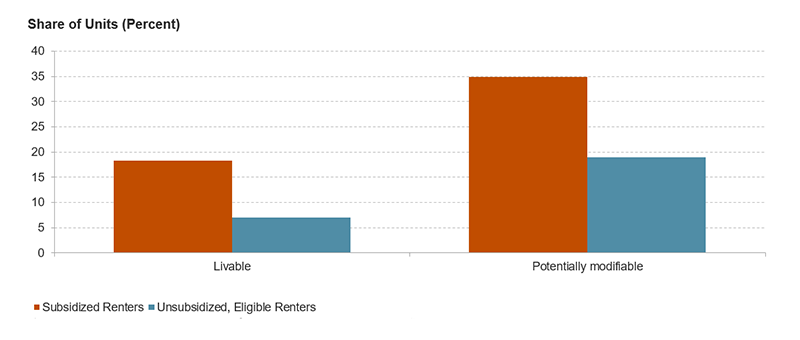Very Few Lower-Income Older Adults Live in Accessible Units
With the aging of the US population, the number of older adult households who are income-eligible for HUD rental assistance is growing rapidly, and older adult households make up a rising share of subsidized renters. Mobility difficulties are common among subsidized older adult renters, and the need for accessible units is widespread. In a new working paper, Accessibility Features for Older Households in Subsidized Housing, Jennifer Molinsky and I investigated whether the subsidized stock is adequately equipped for the aging population, specifically asking if older adult renters receiving HUD support are more likely to live in accessible units than older adult renters who are income-eligible but do not receive HUD assistance.
We answered this question using the American Housing Survey from 2011, the most recent year the survey included detailed questions about household mobility difficulties and housing accessibility. Our subsidized sample included households with at least one person age 65 or older that received HUD rental assistance. We then created a comparison group of eligible, unsubsidized, extremely low-income older renters (those making up to 30 percent of area median income).
We created a variation of the method used in a 2015 HUD report to categorize units as being livable or not in terms of accessibility. “Livable units” were suitable for households with moderate mobility difficulties. At a minimum, these units had the basic structural features of accessible housing, including a no-step entrance into the building, a bathroom and bedroom on the entry level, no steps between rooms (or grab bars along any steps), and grab bars in the bathroom. We also estimated the share of units that were potentially “modifiable,” meaning that they met the first two criteria (no-step entrance as well as bedroom and bathroom on the first level) and could be made livable.
Our first finding was that people in older subsidized households were significantly more likely than eligible renters to have mobility difficulties (such as difficulty stooping or grasping objects) as well as challenges with their housing environment (such as difficulty getting into the bathtub or reaching kitchen cabinets). Of the subsidized households, 60 percent had a member with a disability, with difficulty walking or climbing the stairs being the most prevalent (Figure 1). In comparison, 46 percent of eligible households included a member with a disability. Just over a quarter of older subsidized households included a person who had difficulties with their housing, a significantly higher share than the fifth of older eligible households.
Figure 1: Older subsidized renters have significantly more mobility difficulties
Note: ***p<0.001, **p<0.01, *p<0.05
Source: JCHS tabulations of HUD, American Housing Survey 2011.
In terms of accessibility, we found that the homes of older adults receiving HUD subsidies were significantly more accessible than the eligible comparison group. We estimated that 18 percent of subsidized older households had livable units while another 35 percent lived in homes that could be made accessible (Figure 2). Only 7 percent of eligible older adults had units that were livable in terms of accessibility. This difference could relate to the higher level of disability among older adults in subsidized housing, but the finding held even when controlling for household and housing characteristics. We also found that the chance of residing in a livable unit is 6.1 percent higher for subsidized households than for the eligible renters.
Figure 2: Very few subsidized or eligible older adult renters live in units that are currently accessible
Notes: Livable units have basic accessibility features for a person with moderate mobility difficulties. Potentially modifiable units have a no-step entrance and an entry-level bedroom and bathroom.
Source: JCHS tabulations of HUD, American Housing Survey 2011.
Overall, our results highlight the benefit of subsidized housing but also point to unmet needs. Accessible units, and wheelchair accessible units in particular, are lacking for older, extremely low-income renters, whether they receive a subsidy or not. While many units could be modified to make them accessible, only a small share had basic accessibility features that made them currently accessible for older adults.
There are a few policy interventions that we suggest, including creating reasonable modification funds to help extremely low-income renters pay for accessibility features and revising state Qualified Allocation Plans for Low-Income Housing Tax Credits to prioritize projects with accessibility components. The federal Rental Assistance Demonstration program also offers an opportunity to incorporate greater accessibility into project-based subsidized housing through the redevelopment process.
As its population ages, the US will ultimately need more housing with accessibility features. The lowest-income older adult renters are both the most vulnerable and the least likely to have the resources to modify their housing. Going forward, expanding the affordable, accessible rental stock in a range of neighborhoods should be a planning and policy priority.



